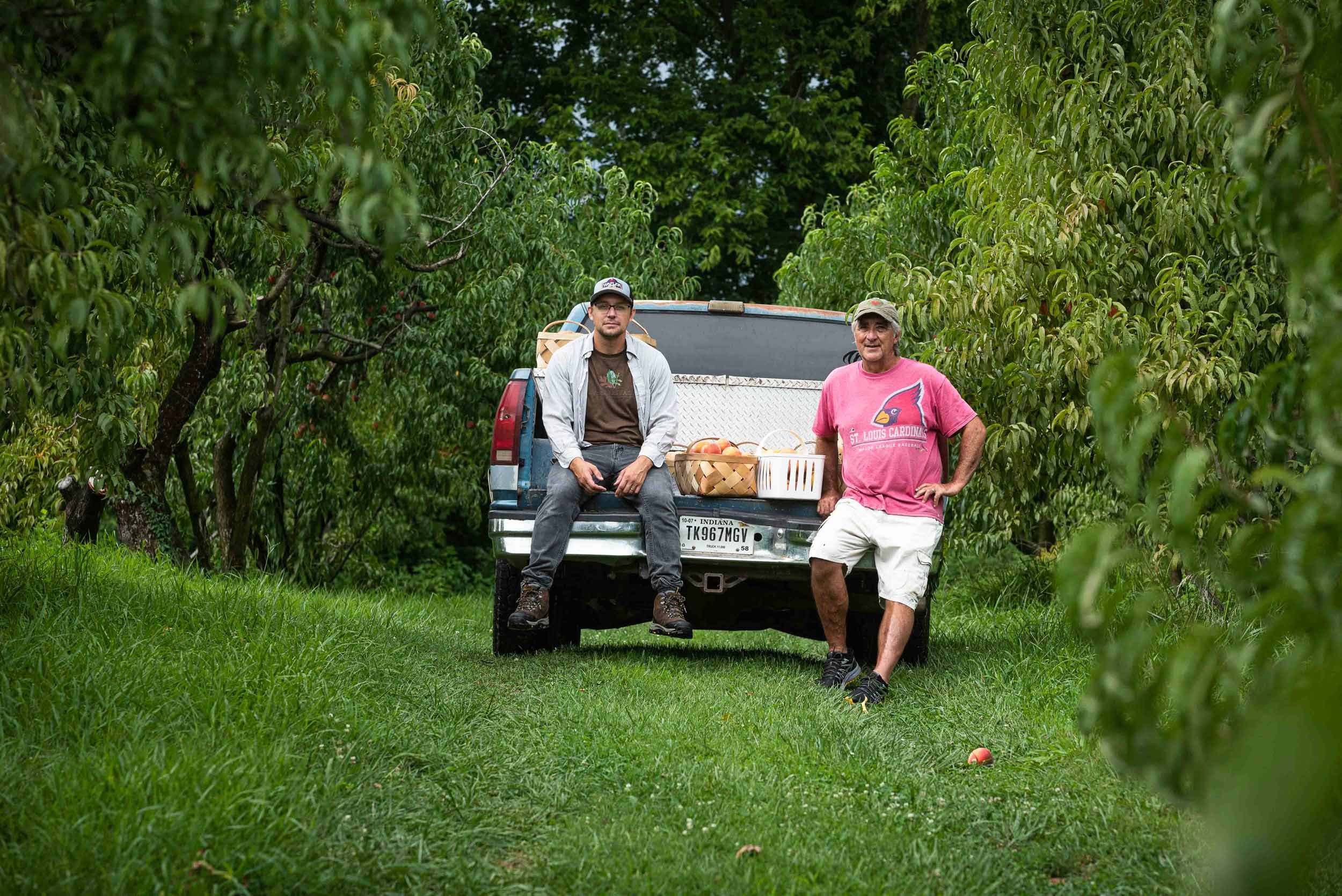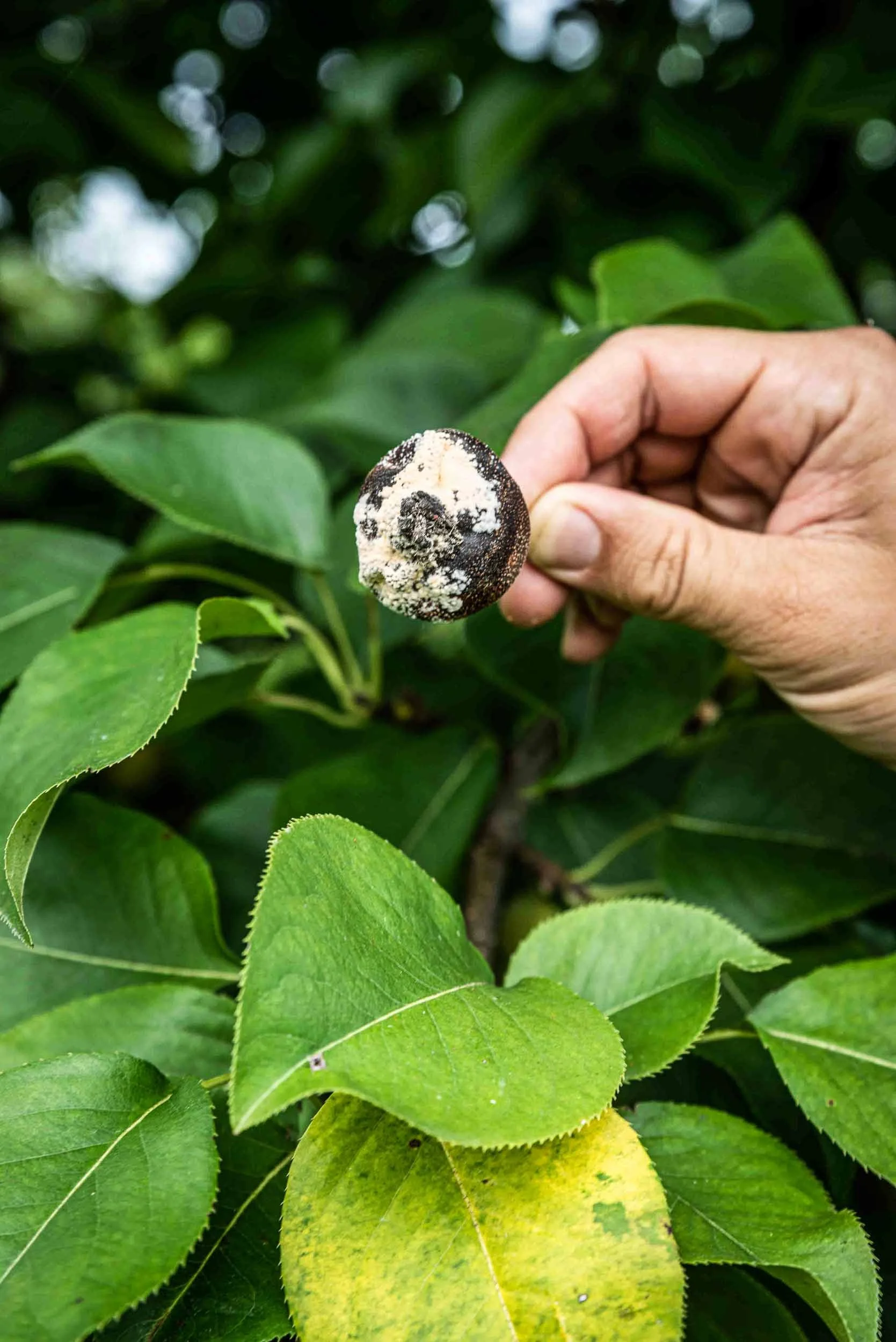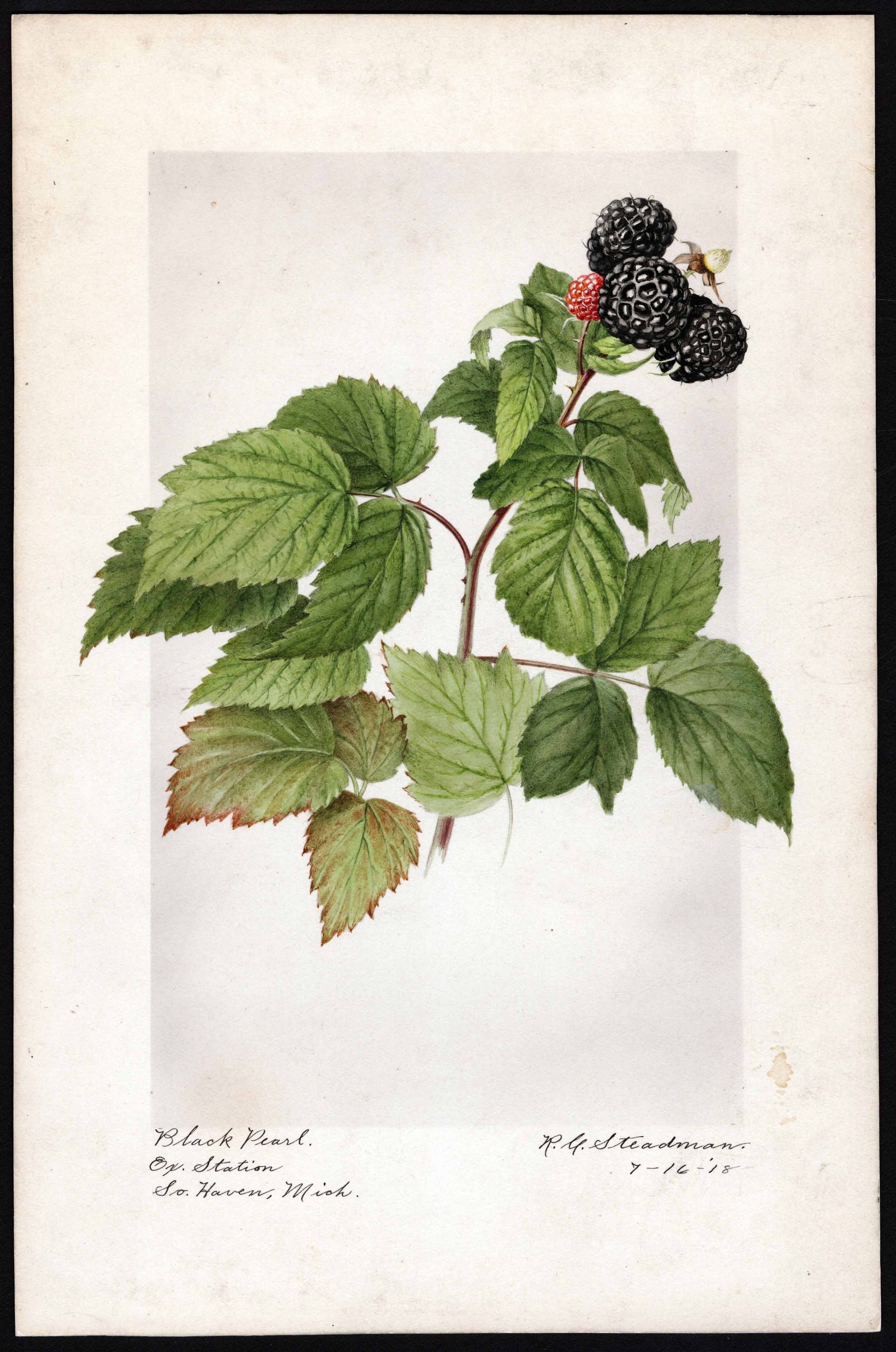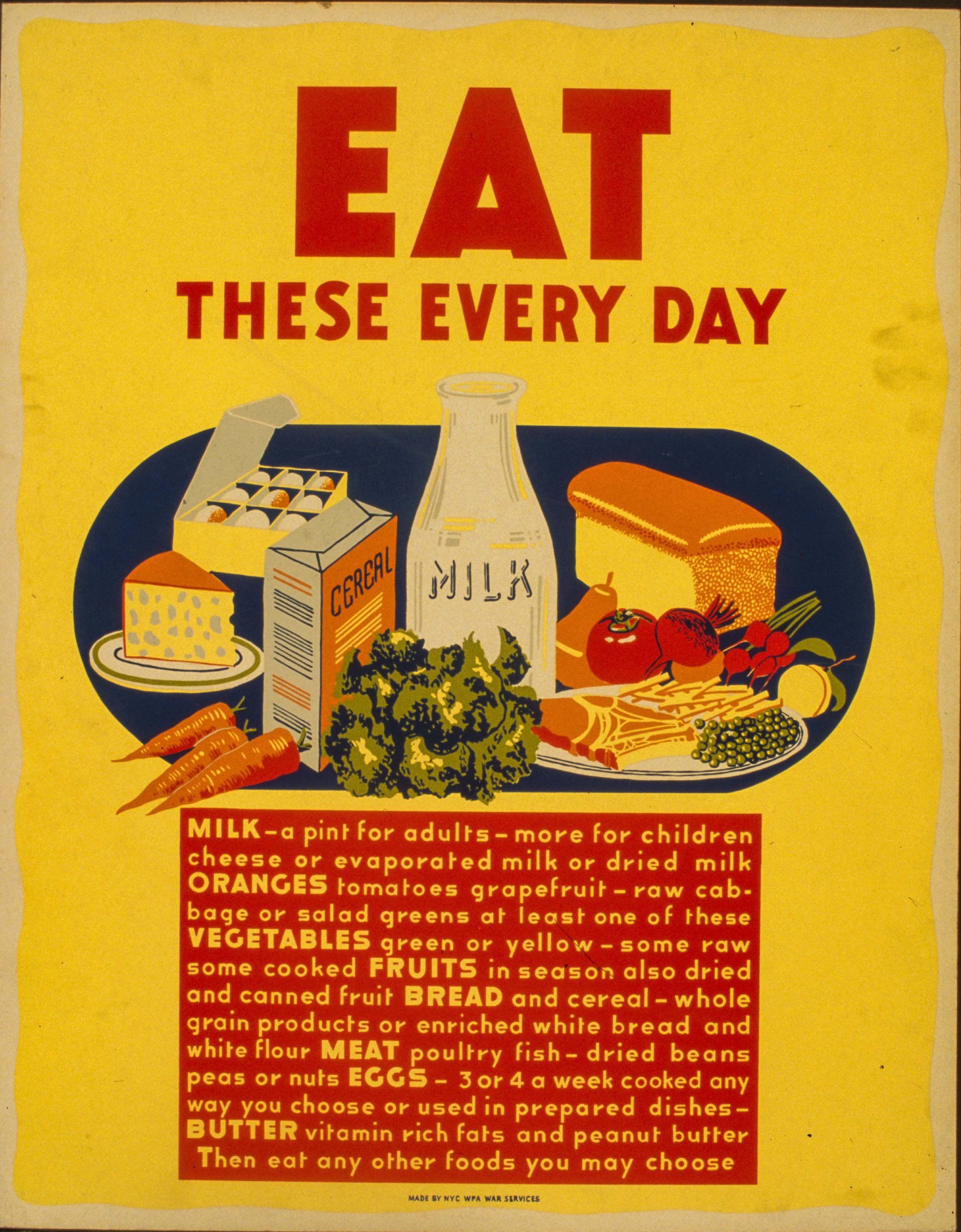Playing the Long Game

With a view that looks from a single growing season to the decades-long productivity of their trees, orchardists have a unique perspective on climate change in the Ohio Valley.
photography by Anjali Fong
This day in June, with temperatures hitting 95 degrees, Nathan Sauerhage dons a Tyvek suit and goes to his apple orchards to spray. “It’s like a sauna inside,” he says. “I can only do it for a few minutes at a time.
“We’re a low-spray orchard,” says Sauerhage, of Backyard Orchards in Rising Sun, IN, “but you have to spray once every week or two in the summer.”
Apples are susceptible to molds and fungus, which proliferate in our humid Ohio Valley climate. Almost all apple farmers spray, even some organic farms. Another apple grower in Indiana, Richard Salatin, says he has taken to doing it at night when it’s cooler.
It’s pretty clear that unseasonable heat waves, like the one in June, are becoming more frequent as global climate change intensifies. The earth is heating up, much like the interior of Sauerhage’s suit. Burning carbon-based fossil fuels leaves extra carbon in the atmosphere, creating a Tyvek-like layer that reflects heat back to earth. Since 1880, the average global temperature has risen almost 2 degrees Fahrenheit, corresponding with a steep, almost doubling rise in atmospheric carbon since the Industrial Revolution.
Top of page: Nathan (left) and Dennis Sauerhage at their Backyard Orchard in Rising Sun, IN. Above is a peach affected with Brown Rot, a fungus caused by too much rain. Dennis says it’s more common later in peach season, when excess rain affects ripe fruit.
Having to work in the new highs of summer heat may be the most visceral, direct impact that a warming climate is having on Ohio farmers. But the reality of rising temperatures, now and in the future, has far more complicated impacts than just higher readings on the thermometer. Climate change means erratic, unpredictable weather, changes in patterns of precipitation, unpredictable frost dates, more severe weather, and conditions for new kinds of pests.
Any farmer will have to cope with its effects. But orchardists like Sauerhage and Salatin have a particularly complicated relationship with weather, and they work in a longer timeline, planting trees that ought to bear fruit 20 or 30 years into this unpredictable future.
“It’s in the back of our minds often,” says Sauerhage, who cultivates 10 acres of orchard, close to the Ohio River, with his father, Dennis. “The effects right now are just adding extra headaches and work, but I worry about the future. I often think about how I don’t want my children to be farmers because of the challenges they’ll face. Of course, we’ll need adaptable young people to deal with the hardships of the future.”
Jack McGlasson and his brother Luke are in the sixth generation of a family that owns orchards along Route 8 in Hebron, KY. Jack says there’s no way to really prepare for what’s ahead. But they have plenty of confidence: They’ve bought new land and planted new trees.
Lots of Variables in Growing
Apples come from the high, dry deserts of Kazakhstan, a much different climate than Ohio. Most apples in the U.S. are grown in the West, where conditions are best. But ever since Johnny “Appleseed” Chapman roamed the Midwest planting apple nurseries in the early days of the Republic, they’ve been grown here, providing hard cider to pioneers, fruit for the most American of pies, and the unique autumnal taste of a locally grown Winesap or Gold Rush.
It’s a bit hotter and more humid than optimal for apples here in the Ohio Valley. But as long as spring warms up steadily, encouraging flowers to open, as long as there are bees that can transfer pollen on their wings as they buzz from one flowering tree to another, as long as diseases don’t ruin the apples or strain the trees, the rain falls reliably, the summer heat ripens the fruit without cooking them on the branch, and the winters are cold but not too cold, they do just fine.
It’s a lot to expect—and every one of those requirements is threatened by new weather patterns. The real disaster-level, livelihood-threatening condition is a warm spring followed by a cold snap. Trees send out blossoms early, which then get frozen and never turn into fruit. Backyard Orchards was wiped out of apples completely in 2020 and had a small crop in 2019. “We lost two-thirds of our crop in 2020,” Jack McGlasson says. “One orchard did fine, the other was wiped out.”
But if the weather stays chilly after the trees bloom, that interrupts pollination. Apple and peach trees are pollinated by both native bees and imported honeybees. “We’ve had some freaky weather in April and May when the fruit was blooming but the weather stayed chilly.” Salatin says. “The bees don’t come out when the temperatures are in the 30s and 40s. We had a beautiful bloom and no freeze, but not a good crop.”
Milder winters are nice for outside farm work. But they create their own problems. “Every tree seems to have a little computer in it counting the hours of cold during the dormant season,” Salatin says. If that biological computer doesn’t count the right number of chill hours, between 30 and 40 degrees, during the winter, blossoming and fruiting will be disrupted.
Apple trees need plenty of water in the ground. Orchards in the western United States are often irrigated. That’s not such a big problem here in Ohio, and global warming is predicted to bring more water to this part of the world. If it comes in huge floods, that’s obviously harmful. But water in the air in the form of our famous humidity is the every-summer problem.
A damp climate encourages scale, mold, and fungus like scab, black rot, cedar apple rust, and fire blight. Some decimate the tree, some kill the apples, others make the fruit imperfect and unappealing. They have to be prevented or stopped. At Backyard, the Sauerhages limit their spraying to coincide with the lifecycle of each problem, they don’t use herbicides or restricted-use chemicals, and they stop spraying well before harvest. But like any orchard, they have to keep the pests at bay with tools they have. That’s an added cost as well as work, and it takes knowledge and skill.
There are also insects, from Japanese beetles to aphids and codling moths, to the newest problem, the spotted lantern fly. Sauerhage points out that an extended period of mild weather means insects and blights can have several more generations within a growing season.
Taking Steps to Mitigate Climate Change
There are ways that farmers can fight all of these conditions, almost trying to create alternative weather. Large commercial apple orchards, like those in the states of New York and Washington, use sprinkler systems or heating to protect blossoms from damage, huge fans to counter humidity, and sometimes nets for protection from hailstorms.
But small Ohio Valley orchard owners can’t afford these kinds of investments. “We don’t grow enough to take advantage of that economy of scale,” McGlasson says. They just try to anticipate a variety of possible problems. “We use the belt and suspenders method,” he says—backups on top of backups.
Fortunately there are disease-resistant apples, lessening the need for spraying. Some of the more popular modern varieties like Honeycrisp are scab-resistant, but susceptible to other pests. And heirloom apples aren’t bred for resistance.
The Sauerhages, concerned about warmer winters, are selecting varieties to plant that do not need as many hours of chill, like Pink Lady and Fuji. Apple trees generally are planted as a rootstock of one variety with another grafted onto it, and mixing and matching those combinations can make trees that do well in a particular environment.
The McGlassons have addressed another climate challenge by installing better drainage to manage unexpected rainstorm deluges. And the Sauerhages and McGlassons have also diversified by investing in peaches. They’re very popular with farmers’ market and farm stand customers. They’re a warm-weather fruit, so they do better in hot summers. But they are even more affected by the warm spring/cold snap problem than apples. No one expects to get a peach crop every year. And they have their own pest problems. Stink bugs, which are insecticide-resistant, love peaches, leaving them with deformities called “catfacing.”
Can the Region Become an Apple Hub?
As climate change makes for new conditions everywhere, it’s possible that Ohio might actually become a better place to grow apples. One farm, farther north in Ohio, was actually planted almost 30 years ago with climate change in mind. Charlie’s Apples in Newark, Licking County, is a commercial orchard that does a difficult thing: growing apples organically.
The farm was originally sited and planted by Charlie Fritsch in 1995. A retired engineer, he wanted to prove that organic apples could be grown in Ohio. He chose the site for his orchard with climate change in mind. He believed that as the Western U.S. gets drier, the center of the country, where water isn’t anticipated to be a problem, might become a more attractive center for fruit growing.
For the last 10 years, brothers Seth and Zach Dobbelaer have leased the orchard and continued to test practices that produce healthy organic fruit. “Climate change could be fixed, but I don’t think it will be,” Zach says. “But we see a significant opportunity to be relevant and figure out how to work with it.
“The site Charlie chose is the second-highest place in the county, and it doesn’t seem to get the killing frost,” Zach continues.
From there, it’s all about making strong trees. They use practices including mulching and denser planting, and cultivate disease-resistant and late-blooming varieties. They test their trees frequently, which tells them what kind of nutrients they need to add. They can then give their trees those nutrients, mostly minerals, in exact doses. They don’t irrigate, but think they may have to in the next 10 years. They’re considering the idea of high hoop houses for some trees.
Zach believes these practices make their orchard more resilient. He also thinks that what they’re doing is a positive gain for climate change. “What we’re trying to do is make more chlorophyll in healthy trees. That pushes more carbons into the ground, so that they’re cycling a lot more carbon out of the atmosphere and storing it in the soil.
“We want to do it profitably,” he continues. “And we also want to share knowledge, farmer-to-farmer. We want to be the kind of people others can reach out to.”
Polly Campbell wrote about restaurants and food and the development of the local food movement for The Cincinnati Enquirer from 1996-2019. She’s a u-pick fiend, a seasonal cook, and believes that money counts differently at farmers markets. A native of Bloomington, Indiana, she and her husband raised two daughters in Cincinnati. She was inducted in the Cincinnati Journalism Hall of Fame this year.









